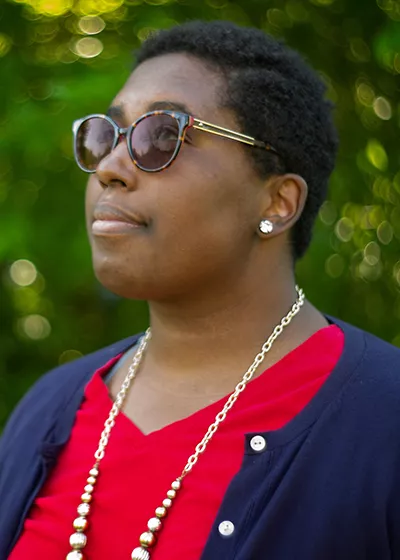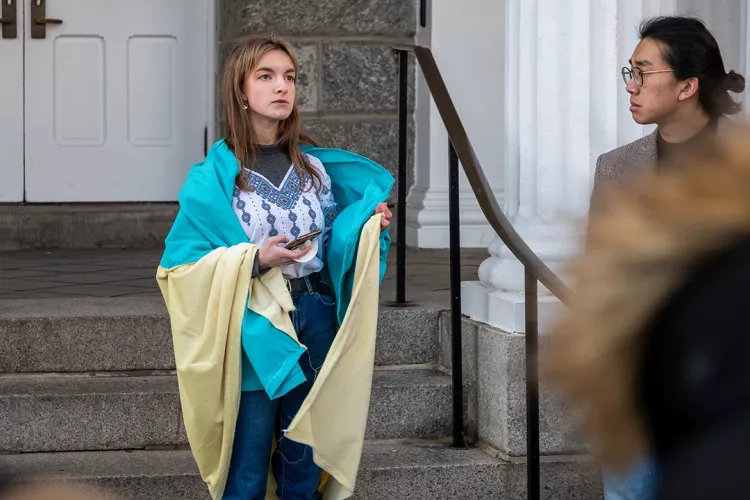Swarthmore Faculty and Alumna Examine Russia-Ukraine War at Community Forums

Kimberly St. Julian-Varnon ’12, a doctoral student in history at the University of Pennsylvania, gave a talk entitled "“What is Going On in Ukraine?”
Amid the rapid acceleration of a new Russia-Ukraine war, Swarthmore presented two forums last week in which the College community considered both its historical context and present horror.
On Friday, the College organized a teach-in titled “Russia/Ukraine: Context, History, Present, Future.” An interdisciplinary panel of speakers addressed the historical roots of the conflict and its effects on the complex web of modern international relations. Professor of Russian Sibelan Forrester moderated the conversation, which featured four other faculty members and an alumna.
Robert Weinberg, Isaac H. Clothier Professor of History and International Relations, spoke first, stating that Vladimir Putin's recent declaration of war has distorted the past in a “willful” and “erroneous” manner. Putin insists that Ukrainian national sovereignty is illegitimate due to linguistic and cultural similarities between Russia and Ukraine; he blames the existence of Ukrainian nationalism on the Soviet regime because the Bolsheviks upheld the expression of Ukrainian national identity, says Weinberg. But for Putin to “collaps[e] the distinction” between Ukraine and Russia is absurd, he says.
Ukraine “has always been multi-ethnic and multinational,” Weinberg adds, and Putin “doesn’t get to tell people who they are.”
Along with misrepresenting history, Russia, a United Nations member, is also “openly flouting international law,” says Associate Professor of Political Science Emily Paddon Rhoads. The U.N. Charter stipulates that armed force should be reserved for national self-defense and that each member state must respect the national territory and sovereignty of its fellows, she noted, and 141 of 193 U.N. states have condemned Russia’s aggression in Ukraine on these grounds.
Paddon Rhoads also praised “heroic and selfless acts of nonviolent resistance and collective non-cooperation” among Ukrainian civilians. But she predicted a “protracted insurgency” in Ukraine, with devastating consequences.
Associate Professor of Anthropology Maya Nadkarni noted the rush of Ukrainian refugees into neighboring Hungary, in the context of refugees from the Middle East being rejected there in 2015. While Hungarian state and civil organizations have shown “an abundance of good intentions and generosity” toward Ukrainian citizens, Nadkarni noted the distressing reality of “uneven distribution of resources, attention, and care.”
Nadkarni and Forrester posited that Ukraine and Hungary bonded over a shared history of oppression on behalf of Russia. In addition, Nadkarni cautioned against viewing the situation through the lens of “U.S. racial categories,” pointing to historical stigma against Ukrainians in Europe.

On February 25, one day after the initial invasion, members of the community met at Parrish Hall for a peace vigil.
Kimberly St. Julian-Varnon ’12, a doctoral student in history at the University of Pennsylvania, picked up this thread in her discussion of race and neocolonialism amid the conflict.
“Ukraine is not a white country,” St. Julian-Varnon explained, and Putin’s “divide and conquer colonial behavior” puts Ukrainian people of color at disproportionate risk.
Afro-Ukrainians; Syrian and Afghan refugees; and Roma, Indian and Middle Eastern students living in Ukraine are “paying the price” of large-scale political conflict, said St. Julian-Varnon, noting that the European Union does not guarantee aid to third-country nationals and calling for Europe and the U.S. to provide unilateral assistance to Ukrainian citizens.
Each speaker said that it is impossible to predict the future: The full impact of Russia's unprovoked attack on Ukraine remains uncertain. While the courage of the Ukrainian people is inspiring, they added, the conflict demands intervention on behalf of nations like the U.S. that are economically and politically situated to offer aid.
Earlier in the week, St. Julian-Varnon helped to contextualize the Russo-Ukrainian war for a packed Scheuer Room crowd of students, faculty, and staff, with her talk: “What is Going On in Ukraine?”
“This is hard,” St. Julian-Varnon said at the event. “I feel like I’m at Swarthmore; I’m at home, I can be honest. I have friends who are in bomb shelters right now. I have friends who have children who are crying because their homes are being bombed. I have friends whose grandmothers are having their last days with COVID [while] being bombarded."
As a writer and Ph.D. student at University of Pennsylvania, St. Julian-Varnon analyzes race and foreign policy in the U.S., Russia, Ukraine, and Central Asia. Her work has been featured in The Moscow Times, Foreign Policy, and Inkstick Media, as well as CNN, NPR, and MSNBC, and she holds an M.A. from Harvard University.
Forrester, who introduced St. Julian-Varnon, said she organized the event a few weeks before.
“It was a crisis when we planned the talk; [now] it is a Russo-Ukrainian war,” said St. Julian-Varnon. “What we are seeing today, is an extensive Russian offensive, essentially to cut off Kyiv from Western Ukraine.”
“Babi Yar, the memorial to one of the worst atrocities the Nazis committed against Eastern European Jews, has been bombed,” she added. “I went by that metro station every day on my way to the archives. So when I speak about Ukraine, I’m not being an academic, I’m being a person. I’m talking about the street I walked on every day.”
St. Julian-Varnon asked Swarthmore students to think critically about Putin’s claims about the war, and especially how they are represented in the media today.
“What does it mean when we ask questions based on the historical propositions of someone like Vladimir Putin?” she asked the audience, “How does this shape the narratives that we’re hearing, that are repeated? What does it mean when someone like Putin says, ‘I’m going to denazify Ukraine,’ whose president, Volodymyr Zelenskyy, is Jewish?”
St. Julian-Varnon urged the audience to consider how they could help.
“All of us can do something — if it’s tweeting, if it’s reaching out, or if you come from a particular community, reaching out to that community,” she said. “Because this is a crisis on both sides of the border in Russia and Ukraine. And it’s going to get much worse. I need everyone to understand that.”
St. Julian-Varnon closed with her “most powerful wish,” which she said she goes to sleep with every night.
“I want Ukraine to survive. I want Russia to survive. I want Russians to experience what life is like without being under the yoke of Putin. I want Ukrainians to realize what it’s like to have a country that has territorial sovereignty.”
The full recording of “Russia/Ukraine: Context, History, Present, Future" is available below.



